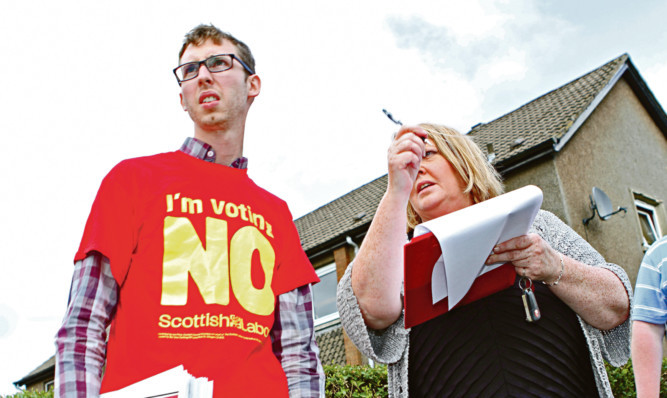
The best way of getting the message out there may simply be talking and listening to voters
For all the talk of being £1,000 better off with a Yes vote or £1,400 with a No, has Labour’s Alex Rowley stumbled upon the winning formula to swaying undecided voters?
The Cowdenbeath MSP and keen gardener was canvassing an elderly couple when they got talking about the menace of slugs ruining their garden. Rowley vowed to fix it by bringing them back some slug pellets from his allotment next time he was passing. “They were undecided right enough so we’ll see,” says the smiling former Fife Council leader. It was a very Cowdenbeath conversation.
Decades on from being the epicentre of Fife’s now-defunct mining industry, the town is still struggling to find its way but it’s a challenge that binds people. The struggles are as well-known as the faces along the town’s long High Street, folk chatting every ten yards. And it is the thousands of life-long Labour voters in this town which the pro-independence camp desperately needs.
This appeal is making some progress, judging by the increased number of Yes stickers and posters on show in the four weeks since my last visit.
But posters don’t win prizes, people do and this is why Alex Rowley is pounding the streets.
“This is where Labour needs to spend its money,” says Rowley, pointing to his team of canvassers as they make brisk work of chapping doors where notably, even though it’s the middle of the afternoon, nearly everyone is in.
“The more time I spend on the doorsteps, the more I’m convinced this is where we need to throw all of our resources.”
He smiles and walks on when I suggest that means it must be time to park the bus, a reference to the flashy red Labour battle bus being driven round the country in a campaign headed by deputy party leader Anas Sarwar.
Rowley, an arch-ally of Gordon Brown, has little to do with Better Together. “I believe they are coming campaigning here later this week,” he says, explaining his stance is just because he has so little in common with the Liberals or Tories.
“I said right from the start we needed a Labour campaign. We didn’t know what to say to people on the doorsteps but we’re now there and I think it’s working.”
In the six or seven streets we cover in two hours, the approach is simple: contact everyone on the electoral roll. A marked difference from the deliberate targeting of undecided voters by both Yes and No camps.
It is an exercise in making sure Labour’s core vote gets out on September 18, a point made by a 74-year-old who doesn’t want to give his name for fear of reprisals and looks visibly relieved when he sees Rowley at his door.
“I’m glad you’re here. We need Labour. Everyone is being too soft on the SNP they’ve got to tell the people how it is.”
Colin Angus, 62, a retired social worker, adds: “Independence flies in the face of what is going on around the world, the idea we can become smaller but more influential. If we’d done this when the oil was first discovered then perhaps it would have worked but not now.”
On several of the doors, granite-faced men give little away. One guy says he is a lifelong Labour voter but undecided. Another only says he’ll vote but his body language, accepting the Labour newspaper like it was a dirty nappy, probably puts him in the Yes camp.
We speak with mainly Labour voters but the Yes supporters are there. Cheryl Lamont, 55, a librarian, reveals that after the weather, the referendum is now the most commonly-raised subject with the people she serves.
She explains her support for Yes. “It is just time for Scotland to stop being told what to do by Westminster. I’m fed up with the way things are run and this is the change we need. This is a Labour area but there are plenty of Yes voters.”
The No voters are resolute but not always clear on why they don’t want the change. Charlene Evans, 40, a mum-of-three, is shouting across the street for a No poster for her front window.
“Why would we want to be independent? It doesn’t make any sense. I just don’t see how it would work. Are we going to need passports to go to England?”
Meanwhile, a neighbour wanders over and explains her mum has told her she needs to vote No or she’ll lose her tax credits. “I live off them so there’s no danger I’m giving them up,” she adds.

Enjoy the convenience of having The Sunday Post delivered as a digital ePaper straight to your smartphone, tablet or computer.
Subscribe for only £5.49 a month and enjoy all the benefits of the printed paper as a digital replica.
Subscribe